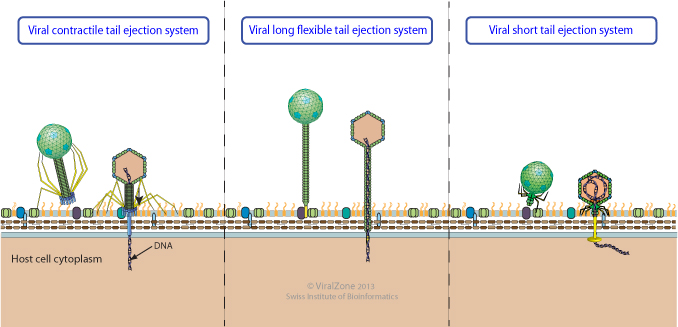Viral genome ejection through host cell envelope (kw:KW-1171)
Tailed bacterial viruses possess are able to enter bacterias by piercing host envelope with their tail. The latter can be long and contractile (e.g. Myoviridae), long and flexible (e.g. Siphoviridae) or short(e.g. Podoviridae).

Delivery into the cell cytoplasm requires ejection of the viral genome from the icosahedral capsid through the tail tube and/or a channel
 .
.
Rossmann MG, Mesyanzhinov VV, Arisaka F, Leiman PG
Curr Opin Struct Biol. 2004 Apr;14(2):171-80
Sun L1, Young LN2, Zhang X1, Boudko SP3, Fokine A4, Zbornik E4, Roznowski AP5, Molineux IJ6, Rossmann MG4, Fane BA
Nature. 2014 Jan 16;505(7483):432-5
Petr G Leiman, Mikhail M Shneider
Adv. Exp. Med. Biol. 2012; 726: 93-114
Casjens SR, Molineux IJ
Adv Exp Med Biol. 2012;726:143-79
Zheng H, Olia AS, Gonen M, Andrews S, Cingolani G, Gonen T
Mol Cell. 2008 Feb 15;29(3):376-83
Letellier L, Boulanger P, de Frutos M, Jacquot P
Res Microbiol. 2003 May;154(4):283-7
Matching UniProtKB/Swiss-Prot entries
(all links/actions below point to uniprot.org website)145 entries grouped by protein
1 entry
Baseplate hub protein gp44 (43 kDa tail protein) (Gene product 44) (gp44) (Gene product P) (gpP)
1 entry
Baseplate puncturing device gp45 (Baseplate spike protein) (Gene product 45) (gp45) (Gene product Q) (gpQ)
5 entries
Capsid protein F (F protein) (GPF)
1 entry
Cargo protein 1 (C1) (Gene product 45) (gp45)
1 entry
Cargo protein 2 (Gene product 46) (gp46)
3 entries
Distal tail protein (Dit) (Gene product 15) (Gp15)
4 entries
Tail knob protein gp9 (Distal tube protein) (Gene product 9) (gp9) (Protein p9)
6 entries
Head-to-tail adapter protein gp4 (Gene product 4) (Gp4) (Internal virion protein gp4) (Peptidoglycan hydrolase gp4) (Tail adapter protein gp4)
1 entry
Tail spike protein (TSP) (Gene product 21) (Gp21)
5 entries
Major spike protein G (G protein) (GPG)
1 entry
Morphogenesis protein 1 (Gene product 13) (gp13) (Protein p13)
1 entry
Internal virion protein gp14 (Gene product 14) (Gp14)
1 entry
Internal virion protein gp15 (Gene product 15) (Gp15)
3 entries
Baseplate protein gp16 (Exolysin) (Gene product 16) (Gp16) (Tail lysozyme-like) (Tail-associated lysine-like protein)
1 entry
Internal virion protein gp20 (Ejection protein gp20) (E protein gp20)
1 entry
Head completion protein gp6 (Connector protein gp6) (Gene product 6) (Gp6)
2 entries
Head completion protein gp7 (Connector protein gp7) (Gene product 7) (Gp7) (Stopper protein gp7)
4 entries
Minor spike protein H (H protein) (Pilot protein)
2 entries
Probable head completion protein 1 (HCP1) (Connector protein gp8)
1 entry
Head completion protein gp15 (HCP) (Connector protein gp15) (Gene product 15) (Gp15)
1 entry
Head completion protein gp16 (Connector protein gp16) (Gene product 16) (Gp16) (Stopper protein gp16)
2 entries
Probable head completion protein 2 (Connector protein gp9) (Gene product 9) (gp9) (Putative stopper protein gp9) (Stopper protein gp9)
5 entries
Tail needle protein gp26 (Head completion protein) (Packaged DNA stabilization protein) (Tail accessory factor gp26)
36 entries
Probable portal protein
1 entry
Major tail tube protein (GpFII-like protein) (Virion protein C)
2 entries
Tip attachment protein J (Central tail fiber) (CTF) (gpJ protein)
2 entries
Tail tip protein L
2 entries
Tail tip protein M
6 entries
Probable tape measure protein (TMP) (Transglycosylase) (EC 4.2.2.n1)
11 entries
Tail sheath protein (TSP)
3 entries
Tail tube terminator protein (TrP) (Gene product 12) (gp12) (Tail-to-head joining protein) (THJP)
3 entries
Proximal tail tube connector protein (Gene product 11) (gp11) (Lower collar protein) (Protein p11)
12 entries
Tail tube protein (TTP) (Gene product 11) (gp11) (Major tail protein) (MTP)
1 entry
Tail tubular protein gp11 (Gene product 11) (Gp11)
1 entry
Tail tubular protein gp12 (Gene product 12) (Gp12)
2 entries
DNA transfer protein gp7
4 entries
Minor spike protein (H protein) (Pilot protein)
1 entry
Infectivity protein P11
1 entry
Protein P18 (GpM) (Protein M)
2 entries
Protein P32
1 entry
Putative DNA transfer protein p33
1 entry
